HOW IS THE WATER is a “virtual ocean experience with real-world impact” that makes ocean accessible for everybody but also pioneer the use of immersive media for marine conservation.
One of the first educational projects created and still today among the most interesting ones for those who want to work in VR and immersive technologies is the one offered in the Biennale College of La Biennale di Venezia. Now in its 6th edition, the Biennale College Cinema VR is an opportunity for creatives and aspiring creatives to meet some of the brightest minds working in the field and to shape and rethink the project with which they joined the workshop using inspirations and knowledge acquired during those days.
In the same year that I first heard of Anagram’s Goliath (2019. Here’s the interview we did with Barry Gene Murphy and May Abdallah at the time; the experience is premiering at the Tribeca Film Festival), my attention was also caught by another project.
HOW IS THE WATER – that’s the title – sounded very promising for several reasons, the two main ones being its use of VR for social good (particularly the oceans and the protection of marine life) and how the core team came from two completely different fields: XR technology on the one hand, environmental science (marine biology) on the other.

At the time, I was struck by the way science, technology but also storytelling came together to create an experience that could strongly benefit from the different perspectives from which it was approached. I continued to follow the work of this team and was fascinated by the way Cyan Planet, the organization they created, became not only – as I had imagined at the beginning – a place for the production of immersive experiences, but it turned out to be a large and passionate network connecting students, associations, scientists, XR enthusiasts, film festivals, museums and others under the same goal:
“[…] to use that empathy to spark action for marine conservation by connecting people with projects and organizations and using immersive media tools to boost the effectiveness of marine organizations” (x)
The organisation is incredibly active and surprisingly effective in the way it makes its supporters feel part of something that inspires them and possibly changes lives. In 2021 I will finally have the opportunity to see the results of these three years and more of work. In the meantime, I contacted director Michal Lovecky and lead researcher Ninja Mueller to find out more about what HOW IS THE WATER has become and what we can expect from it. Here’s what they told me.
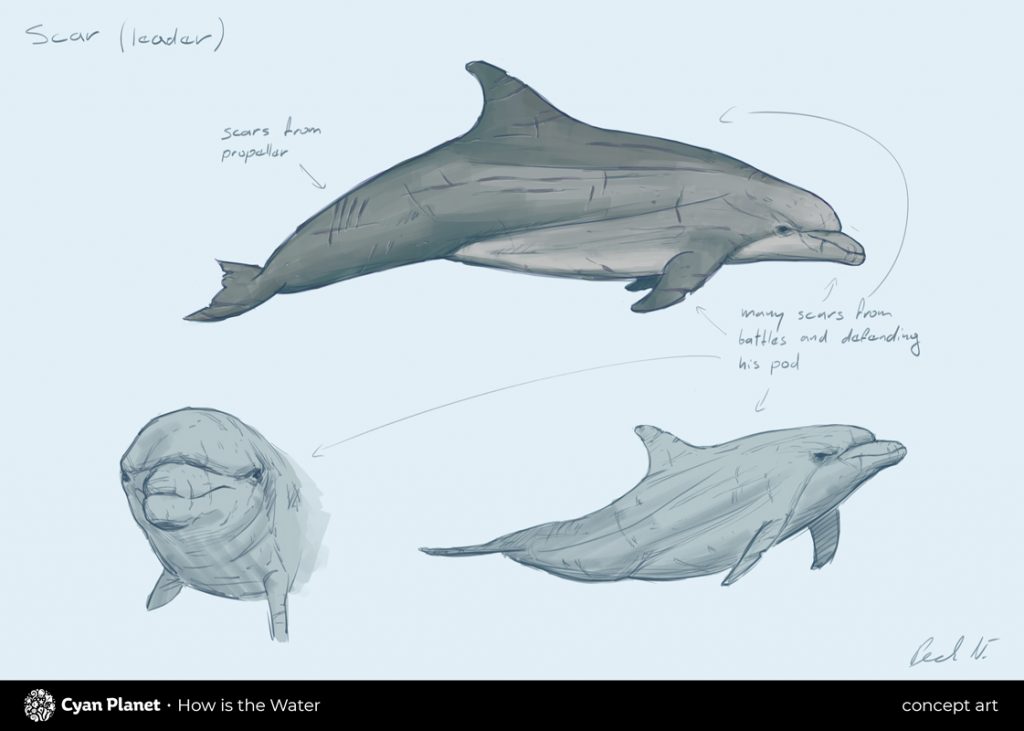
At the origins of HOW IS THE WATER
AGNESE – To being with… How was Cyan Planet born?
We were freediving in the Waters of Fernando de Noronha National Park in Brazil when we discovered a green sea turtle hiding under a part of a wreck. Michal was able to get very close to it, and still, it didn’t move, so he gently pushed it out, and it immediately swam up to the Water’s surface to breathe.
Even though it was just a brief moment, it had a lifelong impact on us, making us realize that every little action can immediately influence the life or death of other living beings.
Half a year later, Michal found the Biennale College Cinema VR application. We both were looking for a way to share our passion for the ocean, so we sat down and created the first concept of HOW IS THE WATER, a project where you become a dolphin and experience the ocean from the perspective of a local. The project then did get selected for Biennale College Cinema VR, which really boosted our motivation. We knew that HOW IS THE WATER would go to the Gap-Financing market at the Venice Film festival, so we made the decision to keep developing it, and established Cyan Planet. Michal brought his expertise in virtual reality and immersive media and other resources needed for our work, and I, as a marine biologist, opened up the marine conservation world.

A. – Why use VR to talk about oceans?
Well, everybody who ever used VR knows that it is an amazing tool to change perspectives, to emotionally engage and to experience instead of watch.
Marine conservation has one major difficulty in its communication to the public: it all takes place in an “alien” world, most people have never been diving or snorkeling, so how could they possibly imagine life underwater, and also – why would they care about something that has no part in their daily life?
It is very difficult to explain to people why to care for something if they cannot relate to it. And here, VR has incredible power because it suddenly makes the ocean accessible for everybody. It makes it understandable and experiential!
A. – Did the Biennale College and the people there inspire you in any way?
The coaching during the College was invaluable. The place and mentors together with all participants shared with us their insights and made us think about the project from new perspectives. Especially for Ninja, since she comes from the marine biology side, it was her first VR event, and she had new enlightenments every day [laughs]
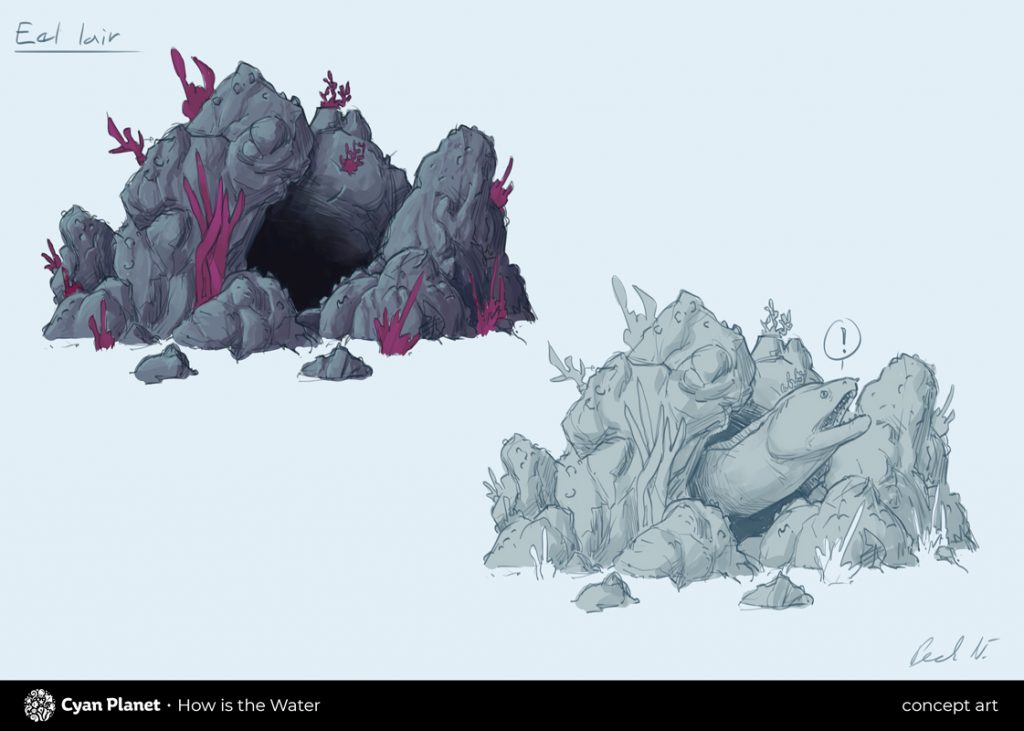
A meeting between environmental sciences and immersive technologies: on the development of HOW IS THE WATER
A. – In the last three years technology has changed, events have changed, the world has changed. How has all this affected the development of HOW IS THE WATER?
In terms of technology, we have seen an incredible leap forward. No longer we need to struggle with cables, base stations, or be looking for a gaming laptop every time we want to get immersed in VR, it becomes more and more accessible.
HOW IS THE WATER as a project is still under development and maturing with every test, feedback, new idea, or experience. It grew from a short VR experience about a dolphin life to a full-blown digital twin of the ocean where you can embody different marine species, expand your senses beyond human abilities, for example echolocation, electroreception or communication via biochemistry, and explore different locations. It also develops along the newest scientific findings about the marine ecosystems, so there will always be changes or updates that we can implement.
Especially concerning the animals, we hope to keep enriching our virtual ocean constantly. The creatures in HOW IS THE WATER are not just any 3D assets, but digital clones of real marine animals, preserving them for future generations and scientific purposes. They are powered by AI for realistic behaviour and reactions to the player, depending on which species they embody. The more animals we are able to scan, the more we can preserve.

A. – The team working on HOW IS THE WATER is made up of VR experts but also marine biologists and scientists. A fantastic combination! I’m very curious about how their different skills come into play in this immersive experience.
Yes, we are really grateful for such a diverse team, coming not only academically from different backgrounds, but also from countries all around the globe.
Everybody can add a valuable perspective, and it’s great to check on each other if we are on the right track. It was also funny to see how the knowledge of one group was passed to the other, for example when our developers started to discuss passionately if the movement of this particular damselfish was correct, or when our marine biologists saw the interface of Unity or Blender for the first time. We all keep learning!
Generally, the scientific aspects were mostly focused on which species can occur and how they should behave, which was then implemented by our developers if possible.
From a linear narrative to an open-world experience
A. – At XRMust we are particularly interested in immersive storytelling: how did you work on the more narrative aspects of HOW IS THE WATER?
HOW IS THE WATER actually started out as a linear narrative experience from a dolphin’s perspective, back at the Biennale College Cinema. But then we realized that with so much effort put into the creation of the underwater world, we can give the players much more than just a dolphin simulator. We expanded the playable characters, in-game challenges, locations, and of course added the connection to real-world marine conservation efforts.
Right now, we do not plan to strictly follow a linear narrative, but we create more of an open-world experience putting emphasis on emergent gameplay, exploration, and interactions. There will certainly be species-specific narrative parts, as well as species-specific challenges, and these aspects will also be the moments when you get up close with the other animals, see their different characters and grow empathic with them through experiencing together.
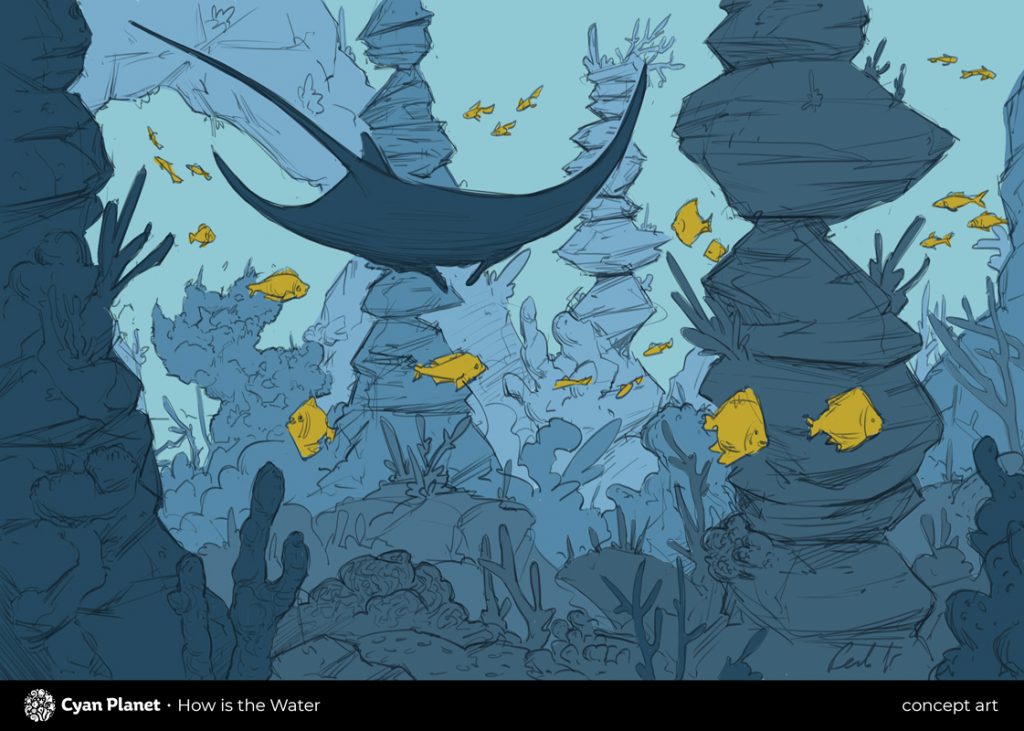
A. – There’s a big Kickstarter campaign underway for HOW IS THE WATER and I just love works that speak to the public and call on them for support. You did work amazingly from this point of view, and really emphasized the social value of this project through every possible media. How are things going in that respect?
Indeed, the campaign is now in its last week on Kickstarter. We already reached over 40 000€, thanks to more than 500 amazing backers!
That being said, our goal is at 50 000 € (a/n the goal was achieved yesterday, 13 June, in an explosive weekend rush), and there is always space to grow. We have multiple stretch goals that we would love to reach, including the preservation of endangered marine animals, more playable characters, because for now it’s only possible to play a dolphin or a tiger shark, and the implementation of new locations in HOW IS THE WATER, for example the deep sea, mangrove or kelp forests, or the arctic.
We’d also like to emphasize that we are not waiting with having an impact and supporting marine conservation efforts; most rewards that you receive for financially supporting the campaign, are directly linked to benefit marine conservation organisations, for example, to restore coral reefs or adopt and protect dolphins.
What happens next depends of course on the success of the campaign, but luckily, HOW IS THE WATER can keep growing with more animals, locations, implemented marine conservation efforts etc., so it will be an ongoing development process, one step at a time.
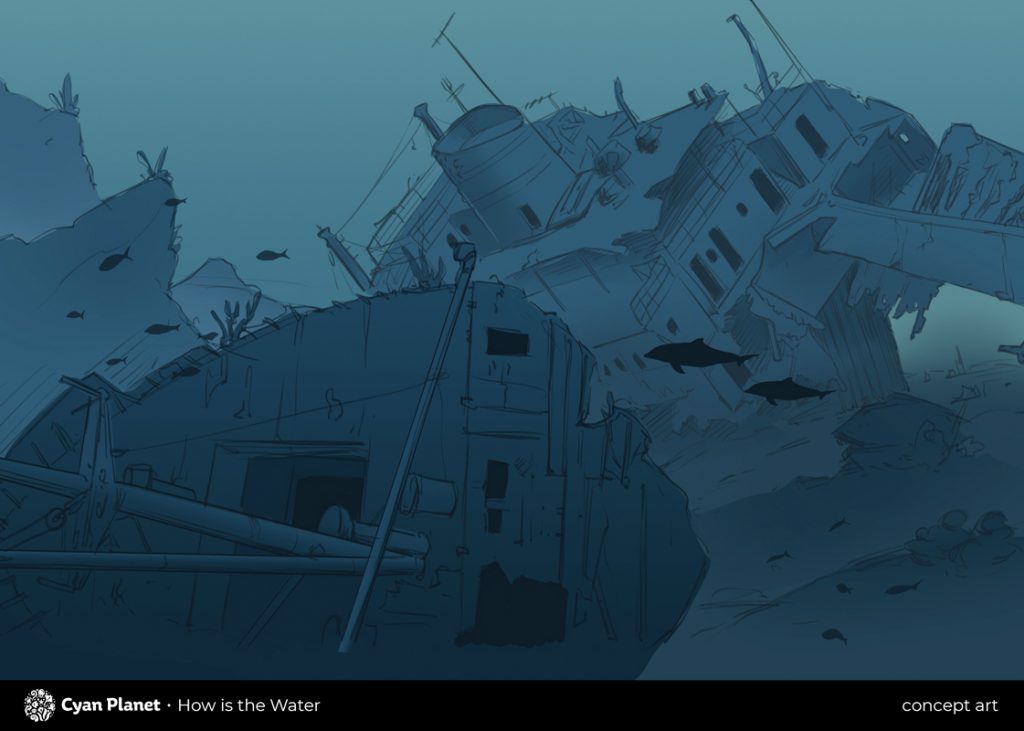
A. – Cyan Planet is not only about HOW IS THE WATER. It is also a network of people who support a common goal and are united by a great love for sea creatures and the oceans. I was surprised by how many students, researchers and associations have joined you. What can you tell us about these collaborations and what are your plans for the future?
We were also surprised at first. Once we noticed that the work was getting too much for two people and we started talking to others about possibly joining the team, it resonated incredibly well, and we grew from four to fourteen members within a month.
Now, we have a core team from 8 different countries, around 50 partner organizations in the fields of XR, marine conservation and education, and about 200 ambassadors from all around the world, all united in our passion to protect the ocean and pioneer the use of immersive media for marine conservation.
All these collaborations bring in new perspectives, as we have people from all around the world and from all kinds of backgrounds, and we really love to develop new ideas with them. The possibilities are as diverse as our community, so, in general, we aim to support marine conservation organizations in their great work, for example by providing immersive media as a tool for training or science communication. HOW IS THE WATER is also a platform to directly connect in-game actions with real-world impact.
Education for sustainable development is also an important pillar of our work that can only be reached with a strong network of passionate people that help us bring the ocean to everybody. Now, during the pandemic, it was of course not possible to access immersive media in public, but we are optimistic that we can start again soon to show our experiences during events, workshops and conferences.
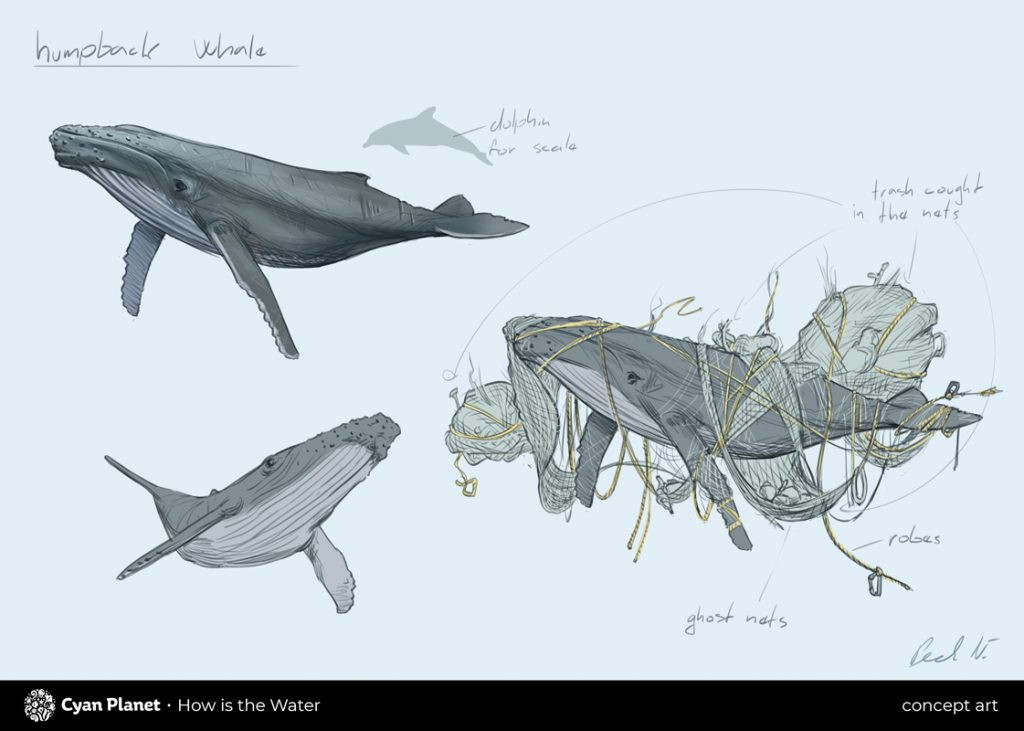
A. – Will you keep working with VR for social change after HOW IS THE WATER? You mentioned to me a platform for VR works dedicated to oceans as part of Cyan Planet’s projects…
We will definitely keep working with VR for social change after HOW IS THE WATER, that’s what Cyan Planet is all about. We do have a few other projects finished or in development that also focus on supporting marine conservation organizations, ocean literacy, and marine science communication.
This platform you mentioned is one of them, still in the very early stages of development. We want to democratize access to immersive media and share our passion for the ocean with as many people as possible. This platform will do that and will also bridge the gap between immersive experiences and real-world conservation action. We will hopefully be able to share with you more soon!
HOW IS THE WATER is the leading virtual reality experience created by Cyan Planet. Updates on it can be found on the official website and on Kickstarter.
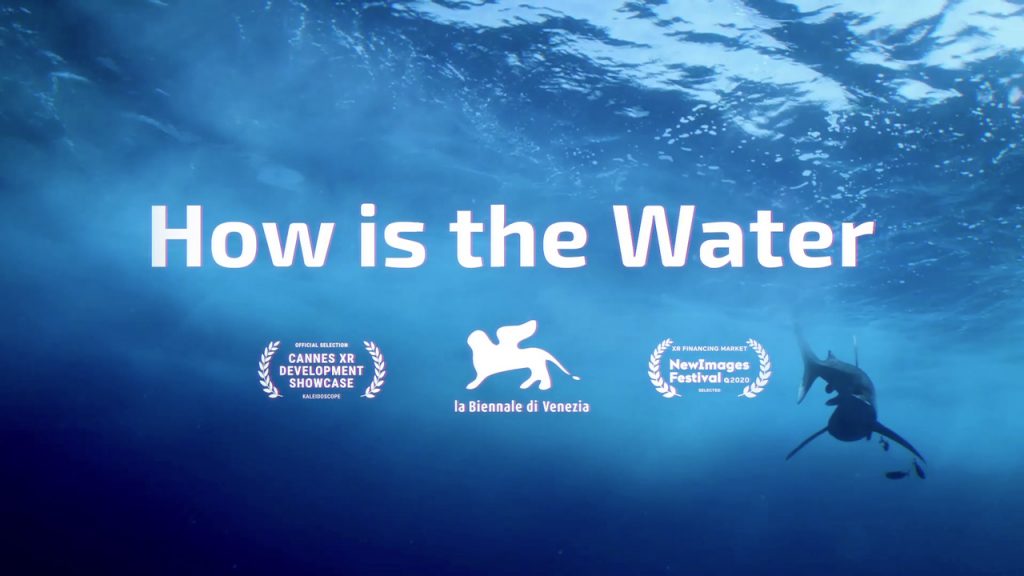



Leave a Reply
You must be logged in to post a comment.